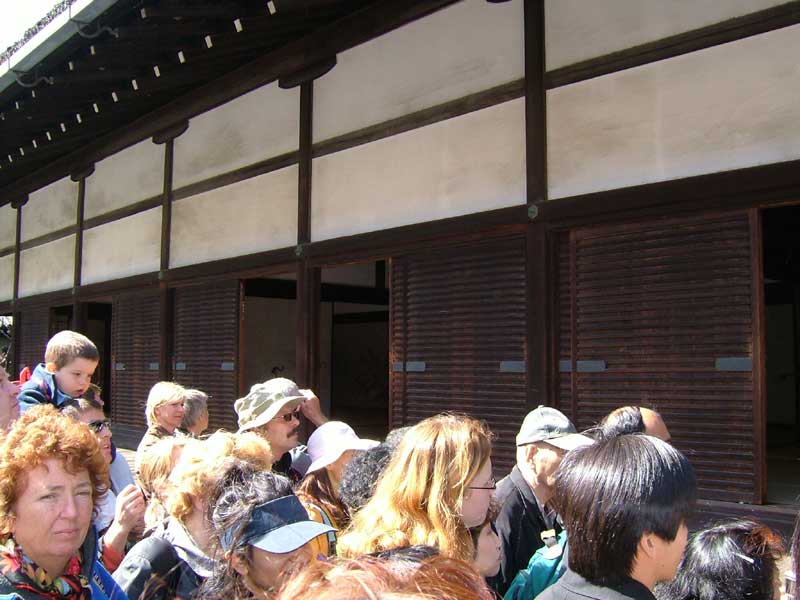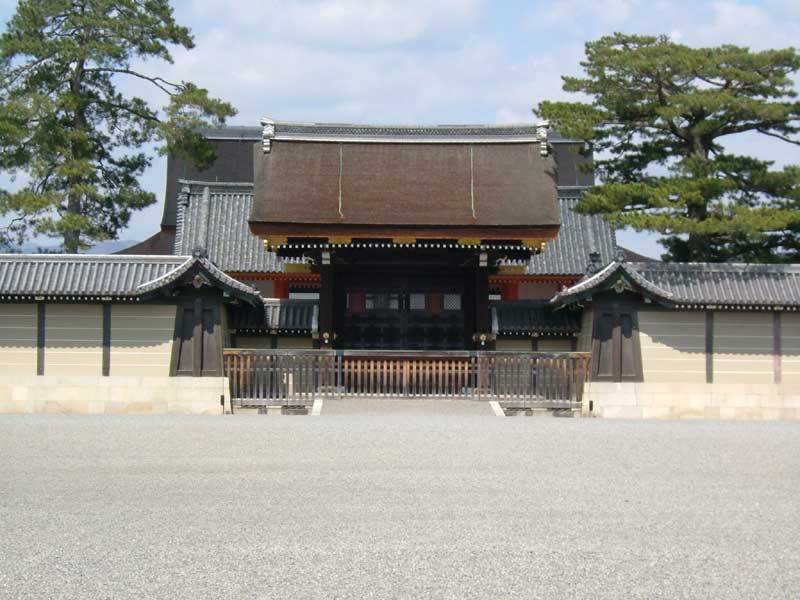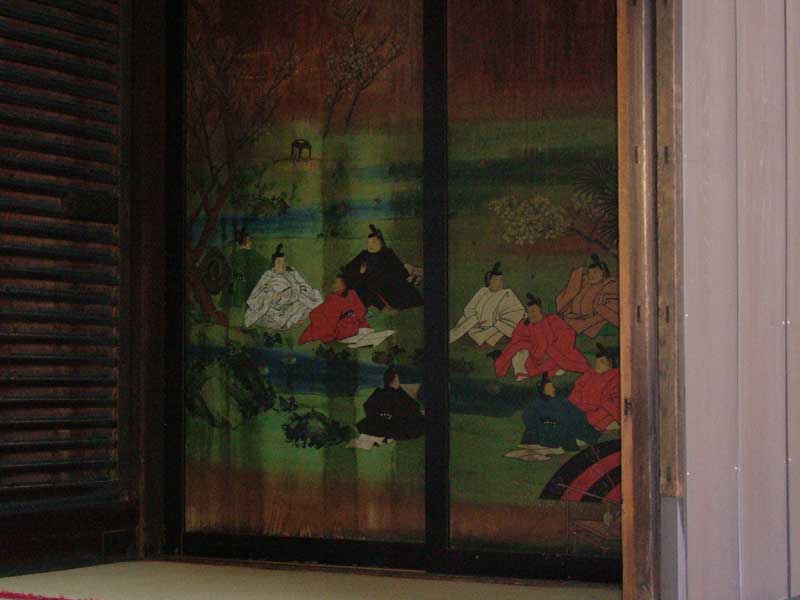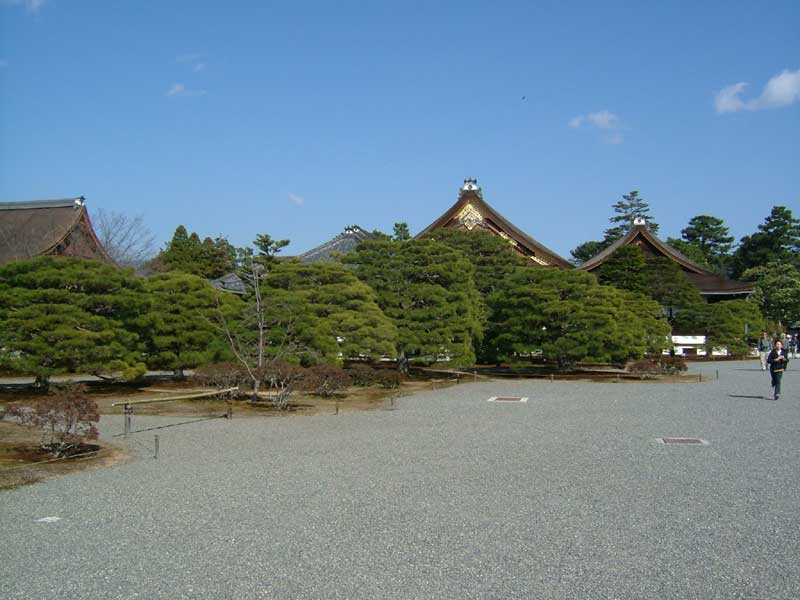

The old Imperial Palace in Kyouto, or Kyouto Gosho, is controlled by the Imperial Household Agency. Visitors to the palace compound need to obtain special permission from the agency. We were told that Japanese people sometimes had to wait months to get permission, but foreigners are given priority access and usually get permission within a few hours. Thinking we would have to produce all sorts of ID, answer questions, and wait a while, Kim and I set out for the agency on our first day. We went in and asked for permission. They gave us a form, we filled it out, and they stamped "PERMISSION GRANTED" on it. It was actually immediate and horribly simple. We signed up for a 2PM English tour for the next day.
Click on the map to look at places we saw, or scroll down for the full tour.
We were told to arrive 20 minutes early for the tour, but in our true style
we arrived geekily-early. So we wandered about the Imperial Grounds for a while.
There are actually three different palace compounds on the grounds, along with
a large park and several small shrines. These turtles were basking in the sun
in a large pond.
Back to map...
In the same pond, we found a charming little shrine on a penninsula. Very picturesque...
so we took a picture (appropriate, isn't it?).
Back to map...
Here's some more picturesqueness involving shrines and Kim. Enjoy.
Back to map...
One cherry tree was in full bloom. It was also fenced off and people were taking
lots of pictures of it. Since we are becoming more Japanese every day, we also
stopped to gape and take pictures.
Back to map...
Like the gardens in Nijo-jo, the Imperial grounds hand many types of flowering
trees. The white flowers are plum trees... not sure what the red ones are.
Back to map...
At last, the time for the tour arrived. The main palace compound has several
gates, each one intended for different types of people. We entered through the
gate intended for servants and the kitchen staff. This gate pictured here is
reserved for the use of nobles visiting the court. They had the privledge of
entering by ox-drawn carriage. Wow! Oxes!
Back to map...
After passing through the gate in ox cart, the nobles dismount and head for
this entrance to the waiting rooms, awaiting audience with the Emperor.
Back to map...
Inside the waiting area were three separate rooms, each with a representative
animal of corresponding honor with the ranks of the nobles who would wait in
that room. High nobles waited in this tiger room (there are no, and never were
any tigers in Japan, by the way... the artist drew tigers by description, having
never seen one).
Back to map...

Lesser nobles waited in the crane and whatever-the-other-one-was-because-I-forgot
rooms, pictured here.
Back to map...
Further along was the reception hall, which the nobles walked along to meet
and greet the Emperor. This is the outside entrance.
Back to map...
Past the reception area is the throne room and its courtyard. Every historical
Emperor except the current one has been enthroned here. This is the side entrance.
Back to map...
Here is a head-on view of the throne area. Well-wishers would stand in the
courtyard to watch the proceedings. The current Emperor was not enthroned here
because there isn't enough room, and there is a conspicuous lack of important
facilities such as flush-toilet bathrooms.
Back to map...
Here's a close-up of the throne room. It isn't a very good angle, but you can
see the base of the Emperor's throne and the very outer corner from the Empress's
throne. This is the oldest-style building, and the doors swing upwards. Apparently
they're extrodinarily heavy as well.
Back to map...
The pavilion around the courtyard has a clay-tiled room of the type typical
to most older Japanese houses. On the end of each tile row is a chrysanthemum--symbol
of the Emperor.
Back to map...
Here is the gate by which the Emperor and, if accompanied by the Emperor, the
Empress enter the palace.
Back to map...

Here is an outside picture I took of the same gate earlier in the day. Notice
that the palace walls are not made of stone, and thus the compound would be
relatively easy to attack. Fortunately for the Emperor, no one would ever have
dreamed of attacking him.
Back to map...
If she arrived by herself or with the princes and princesses, this is the entrance
the Empress would use. The crown prince also arrived through here. And yes,
that woman is wearing a surgical mask. It's very common in Japan (and Asia,
I gather).
Back to map...
This is where the Empress slept. Seems a bit exposed. However, if you read
the "Tale of Genji" you can get a pretty accurate idea of how all
those different doors, screens, and sheets were used so high nobles could talk
with the empress without actually seeing her or technically be in the same room
as her. "Seeing" her implied naughtiness.
Back to map...
This part of the compound was the residential building for the Emperor. The
roof of this building is compressed cedar bark, which must be replaced every
30-40 years. This particular building had just had the roof completed a few
months previously. The clay tile style roofs need replacing every 70-80 years.
Back to map...

Along the corridors on the outside of the Emperor's residence were many screen
paintings like this one. This particular painting portrays a poetry reading
in the garden--a very popular activity to which only the best poets were invited.
The early poems were written in Chinese and most relate to nature and the seasons.
Given that the 4 normal seasons are subdivided resulting in 24 seasons, the
obsession with seasons is not surprising.
Back to map...
This is the Emperor's garden. It was designed to imitate the sea, and it was
extrodinarily carefully planned by the garden architect. Sometimes the gardens
received more effort in their creation than did the buildings. One had to be
very special (like Kim) to have the privledge of visiting the emperor's garden.
Back to map...
This is where our tour wrapped up. It used to be the kitchen buildings; however,
they were never rebuilt after the last fire. You can see quite a bit of the
palace complex from here.
Back to map...

This is the other side of the palace complex. We left the palace the same way
we entered--through the servants' gate.
Back to map...